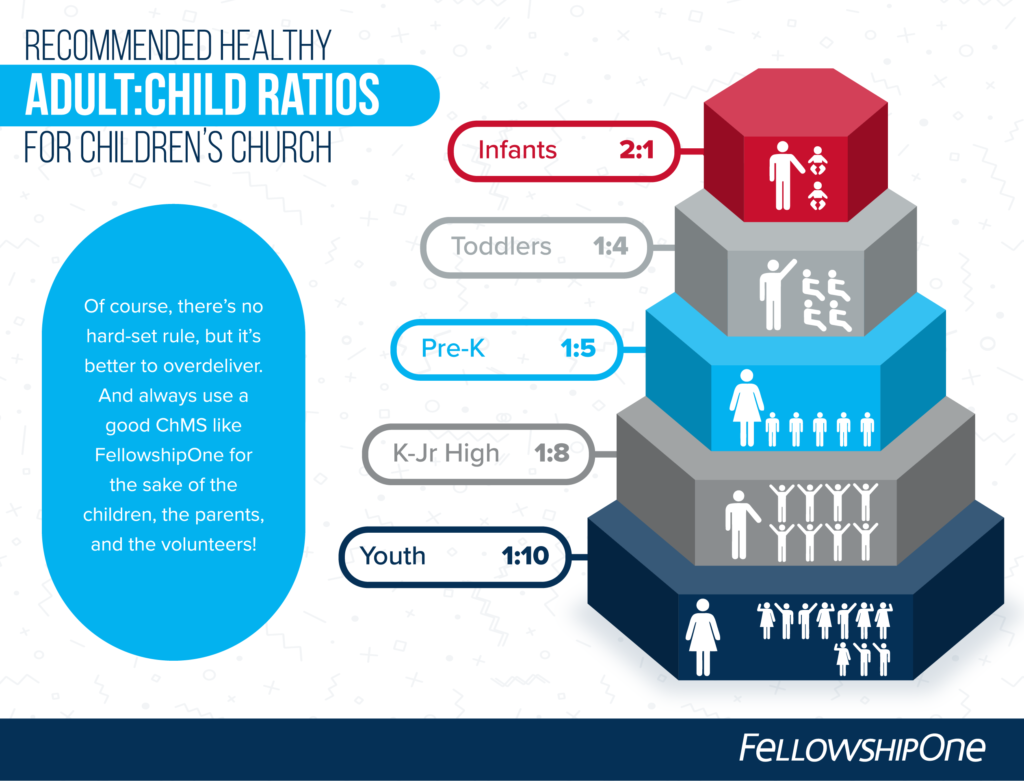
There’s nothing greater than a bustling children’s church, filled with kids eager to play, have fun, and learn about the Lord. But when children’s church classrooms aren’t staffed with enough volunteers, things can go wrong and the ability to have a controlled learning environment can go out the window.
A Healthy Adult:Child Ratio Promotes Safety
A healthy adult-to-child ratio in any children’s church is important for a number of reasons, the first of which is safety. Kids love to play…and run…and jump…and get physical. If there aren’t enough trained volunteers helping out in any given classroom, injuries can result—which are not only dangerous for the kids, but they also are one of the quickest ways to turn parents away from the church.
A Healthy Adult:Child Ratio Promotes Learning and Fun
Of course, one of the main reasons parents drop their kids off at children’s church is the hope that they’ll come away from the experience having learned something new from the Bible. Chaos hurts learning; whereas, order increases it. Having more workers on staff means disorderly conduct can be dealt with individually without disrupting the flow of the message or class activities. A good ratio makes learning better—and more fun—for everyone.
A Healthy Adult:Child Ratio Keeps Volunteers Returning
At the same time that kids benefit from a healthy adult:child ratio, so do the adults! In children’s ministry, almost all the adults are volunteers—and keeping them coming back means promoting an environment to which they want to return. This means making sure that the burden of order doesn’t rely on just one or two people, but rather a group of volunteers collectively…making the experience that much more enjoyable and manageable.
A Healthy Adult:Child Ratio Varies
That said, a healthy adult:child ratio varies, depending on the age of the children. The older the kids are, the more they’ve developed, and the fewer adults that are necessary to maintain an orderly environment. Older kids also tend to grow more interested in building personal relationships through talking rather than only through activities, so there is slightly less motion happening in the older classrooms.
Common Healthy Adult:Child Ratios
While there is no hard-and-fast rule for healthy adult:child ratios in a children’s church classroom, the following is a good guideline.
- For infants, there should be one adult for every two children.
- For toddlers, that doubles: one adult for every four children.
- Once children are walking through Pre-K, one adult for every five children is a good rule.
- And for children Kindergarten to junior high, one adult for every eight kids makes for strong classrooms.
- Once kids get to youth age, generally one adult for every 8-10 kids is enough.

Of course, state adult:child minimum standards are generally much lower for childcare, but in children’s church, you always want to over-deliver, especially when your staff are volunteers.
Build a Healthy Adult:Child Ratio with a Good ChMS
As you’re working toward a healthy adult:child ratio in your classrooms, a good Church Management Software can help leaders ensure that volunteers have shown up and the classrooms are covered for every service. Checking kids—and volunteers—in is a vital step toward making sure every classroom is as strong as it can be.
If you’re looking for an efficient check-in system for your church, fill out this form and we will contact you to schedule a free, personalized demonstration of how FellowshipOne can make your children’s church run smoothly every week!




